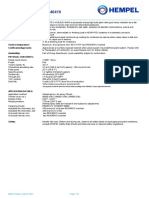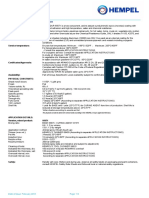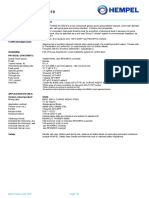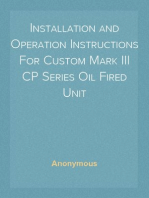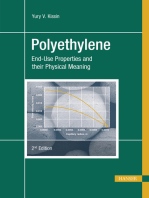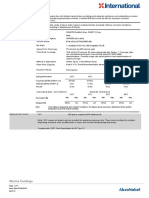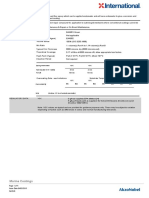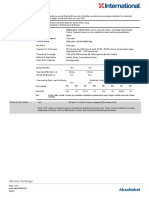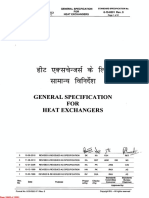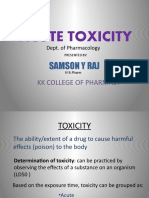Hempadur Fast Dry 17410 En-Gb
Hempadur Fast Dry 17410 En-Gb
Uploaded by
Trịnh Minh KhoaCopyright:
Available Formats
Hempadur Fast Dry 17410 En-Gb
Hempadur Fast Dry 17410 En-Gb
Uploaded by
Trịnh Minh KhoaOriginal Description:
Original Title
Copyright
Available Formats
Share this document
Did you find this document useful?
Is this content inappropriate?
Copyright:
Available Formats
Hempadur Fast Dry 17410 En-Gb
Hempadur Fast Dry 17410 En-Gb
Uploaded by
Trịnh Minh KhoaCopyright:
Available Formats
Product Data
HEMPADUR FAST DRY 17410
17410: BASE 17419: CURING AGENT 98410
Description: HEMPADUR FAST DRY 17410 is a two-component epoxy paint, which combines high volume solids
with a short drying time. Contains zinc phosphate for better corrosion protection.
Recommended use: HEMPADUR FAST DRY 17410 is suitable for onshore corrosion protection of new-build steel
constructions where fast to handle and short overcoating times are required, such as steel for factory
buildings, stadiums, exhibition halls, airports, power plants, refineries, chemical and petrochemical
plants.
Service temperature: Maximum, dry exposure only: 140°C/284°F
Certificates/Approvals:
Availability: Part of Group Assortment. Local availability subject to confirmation.
PHYSICAL CONSTANTS:
Shade nos/Colours: 11320* / Grey. (see REMARKS overleaf)
Finish: Semi-gloss
Volume solids, %: 74 ± 1
Theoretical spreading rate: 7.4 m2/l [296.7 sq.ft./US gallon] - 100 micron/4 mils
Flash point: 26 °C [78.8 °F]
Specific gravity: 1.6 kg/litre [13 lbs/US gallon]
Surface-dry: 45 minute(s) 20°C/68°F
Through-dry: 2.5 hour(s) 20°C/68°F
Fully cured: 7 day(s) 20°C/68°F
VOC content: 246 g/l [2 lbs/US gallon]
Shelf life: 3 years for BASE and 1 year (25°C/77°F) for CURING AGENT from time of production.
- *other shades according to assortment list.
- The physical constants stated are nominal data according to the HEMPEL Group's approved formulas.
APPLICATION DETAILS:
Version, mixed product: 17410
Mixing ratio: BASE 17419: CURING AGENT 98410
4 : 1 by volume
Thinner (max.vol.): HEMPEL'S THINNER 08450 <5% depending on purpose (see REMARKS overleaf)
Pot life: 1.5 hour(s) 20°C/68°F
Nozzle orifice: 0.019 - 0.021 "
Nozzle pressure: 225 bar [3262.5 psi]
(Airless spray data are indicative and subject to adjustment)
Cleaning of tools: HEMPEL'S TOOL CLEANER 99610
Indicated film thickness, dry: 70-125 micron/2.8-5 mils
Indicated film thickness, wet: 100-175 micron/4-7 mils
Overcoat interval, min: see REMARKS overleaf
Overcoat interval, max: see REMARKS overleaf
-
Safety: Handle with care. Before and during use, observe all safety labels on packaging and paint containers,
consult HEMPEL Safety Data Sheets and follow all local or national safety regulations.
-
-
-
-
-
-
-
-
-
-
-
-
Date of issue: October 2017 Page: 1/2
Product Data
HEMPADUR FAST DRY 17410
SURFACE PREPARATION: Steel work: The steel surface shall be thoroughly prepared so that the coating achieves an even
distribution at the specified nominal dry film thickness (please refer to the specifications). The final
steel condition including welds and edges shall conform to preparation grade P2 (ISO 8501-3).
New steel: Abrasive blasting to Sa 2½, (ISO 8501-1:2007), with a surface profile equivalent to
Rugotest No. 3 BN 10b, Keane-Tator Comparator 3.0 G/S or ISO Comparator, rough MEDIUM (G). For
temporary protection, if required, use a suitable shopprimer. All damage of shopprimer and
contamination from storage and fabrication should be thoroughly cleaned prior to final painting. For
repair and touch-up use: HEMPADUR FAST DRY 17410.
Maintenance: Remove oil and grease etc. thoroughly with suitable detergent. Remove salts and other
contaminants by high pressure fresh water cleaning. Remove all rust and loose material by wet or dry
abrasive blasting or power tool cleaning. Feather edges to sound and intact areas. Dust off residues.
Touch up to full film thickness. After wet abrasive blasting hose down the surface with fresh water and
allow drying.
APPLICATION CONDITIONS: Apply only on a dry and clean surface with a temperature above the dew point to avoid condensation.
Use only where application and curing can proceed at temperatures above: -10°C/14°F.
The temperature of the paint itself should be: 15-25°C/59-77°F.
In confined spaces provide adequate ventilation during application and drying. Thinning may be
necessary in the case of very long spray hoses and/or paint temperatures below: 15°C/59°F. This will
cause lower film build and longer drying time.
PRECEDING COAT: None, or as per specification.
SUBSEQUENT COAT: None, or as per specification.
REMARKS:
Colours/Colour stability: Has a tendency to yellow after application. This will have no influence on the performance.
Weathering/service temperatures: The natural tendency of epoxy coatings to chalk in outdoor exposure and to become more sensitive to
mechanical damage and chemical exposure at elevated temperatures is also reflected in this product.
Application(s): Irregular surfaces: Similar to other very fast drying/curing epoxies; this product is sensitive towards
the geometry of irregular surfaces. Special care should be taken in relation to irregular surfaces
(welding seams, undercuts, corners etc.) as application with an excessive film thickness may result in
cracking.
Film thicknesses/thinning: Film thickness:
The recommended nominal dry film thickness (NDFT) is 70-125 micron/2.8-5 mils.
Overthickness on irregular surfaces shall be avoided or highly controlled.
Overthickness on overlapping areas, corners, welding seams, etc should be less than 225 μm/9 mils
DFT.
Thinning:
Selection of proper thinner is related to application conditions. Recommended thinner(s): HEMPEL'S
THINNER 08450 and HEMPEL'S THINNER 08700.
Shades: The product is also available in a Micaceous Iron Oxide (MIO) pigmented shade (Shade no. 12430 –
reddish grey).
Overcoating: Overcoating intervals related to later conditions of exposure: If the maximum overcoating interval is
exceeded, roughening of the surface is necessary to ensure intercoat adhesion.
Before overcoating after exposure in contaminated environment, clean the surface thoroughly with high
pressure fresh water hosing and allow drying.
A specification supersedes any guideline overcoat intervals indicated in the table.
Environment Atmospheric, medium
Surface temperature: -10°C (14°F) 0°C (32°F) 20°C (68°F)
Min Max Min Max Min Max
HEMPADUR 18 h Ext.* 9h Ext.* 2h Ext.*
HEMPATHANE 18 h 90 d 9h 45 d 2h 10 d
NR = Not Recommended, Ext. = Extended, m = minute(s), h = hour(s), d = day(s)
Overcoating note: *Depending on actual local conditions, the long maximum overcoating intervals may vary.
Contact HEMPEL for more information.
Note: HEMPADUR FAST DRY 17410 For professional use only.
ISSUED BY: HEMPEL A/S 1741011320
X Move PDS Disclaimer to Second page
This Product Data Sheet supersedes those previously issued.
For explanations, definitions and scope, see “Explanatory Notes” available on www.hempel.com. Data, specifications, directions and recommendations given in this data sheet
represent only test results or experience obtained under controlled or specially defined circumstances. Their accuracy, completeness or appropriateness under the actual conditions
of any intended use of the Products herein must be determined exclusively by the Buyer and/or User.
The Products are supplied and all technical assistance is given subject to HEMPEL's GENERAL CONDITIONS OF SALES, DELIVERY AND SERVICE, unless otherwise expressly agreed
in writing. The Manufacturer and Seller disclaim, and Buyer and/or User waive all claims involving, any liability, including but not limited to negligence, except as expressed in said
GENERAL CONDITIONS for all results, injury or direct or consequential losses or damages arising from the use of the Products as recommended above, on the overleaf or otherwise.
Product data are subject to change without notice and become void five years from the date of issue.
Date of issue: October 2017 Page: 2/2
You might also like
- BFP ReviewerDocument11 pagesBFP ReviewerTheresa84% (43)
- Explain How The Photon Concept and The FactDocument13 pagesExplain How The Photon Concept and The FactSophie Anne Trinidad Battung100% (1)
- Hempaprime Multi 500 Summer 45950Document3 pagesHempaprime Multi 500 Summer 45950omar alkarabliehNo ratings yet
- Pds Hempadur 35900 En-GbDocument2 pagesPds Hempadur 35900 En-Gbluisbarrios104No ratings yet
- PDS Hempadur Multi-Strength 35842 en-GBDocument2 pagesPDS Hempadur Multi-Strength 35842 en-GBIfrahimNo ratings yet
- Soldering electronic circuits: Beginner's guideFrom EverandSoldering electronic circuits: Beginner's guideRating: 4.5 out of 5 stars4.5/5 (10)
- Pds Hempadur Speed-Dry ZP 500 En-GbDocument3 pagesPds Hempadur Speed-Dry ZP 500 En-GbDHANOOPNo ratings yet
- Hempadur Zinc 17380Document2 pagesHempadur Zinc 17380sizmaruNo ratings yet
- Hempel - S Zinc Primer 16490Document2 pagesHempel - S Zinc Primer 16490Haryanto RNo ratings yet
- PDS HEMPADUR 15553 en-GBDocument2 pagesPDS HEMPADUR 15553 en-GBachusanachuNo ratings yet
- Hempadur 15553Document2 pagesHempadur 15553EngTamerNo ratings yet
- PDS HEMPATHANE FAST DRY 55750 en-GBDocument2 pagesPDS HEMPATHANE FAST DRY 55750 en-GBEli KhawNo ratings yet
- PDS Hempadur Fast Dry 15560 en-GBDocument2 pagesPDS Hempadur Fast Dry 15560 en-GBErwin MalmsteinNo ratings yet
- PDS en-GB 16490Document2 pagesPDS en-GB 16490Anuar SalehNo ratings yet
- Hempadur Zinc 17340 17340Document2 pagesHempadur Zinc 17340 17340Sachin NambiarNo ratings yet
- Hempadur Quattro InglesDocument3 pagesHempadur Quattro InglesElizabeth Maria Bazán MoralesNo ratings yet
- Hempadur Zinc 17360Document2 pagesHempadur Zinc 17360Bang OchimNo ratings yet
- Product Data: Hempel'S 15asgDocument2 pagesProduct Data: Hempel'S 15asgwahyu0% (1)
- Paint Specification HamadourDocument2 pagesPaint Specification HamadourAbdul Majid LodhiNo ratings yet
- PDS HEMPADUR EASY 47700 en GBDocument3 pagesPDS HEMPADUR EASY 47700 en GBharshana divankaNo ratings yet
- Pds Hempatex Hi-Build 46410 En-GbDocument2 pagesPds Hempatex Hi-Build 46410 En-GbMohamed ChelfatNo ratings yet
- Hempadur Avantguard 750 1736g - Product DatasheetDocument2 pagesHempadur Avantguard 750 1736g - Product DatasheetWisnu Wardhana0% (1)
- 151SGDocument2 pages151SGdcsamaraweeraNo ratings yet
- Pds Hempadur 85671Document2 pagesPds Hempadur 85671Namta GeorgeNo ratings yet
- Hempadur 85671Document2 pagesHempadur 85671EkoAndriAntoNo ratings yet
- PDS Hempadur Multi-Strength 45753 en-GBDocument2 pagesPDS Hempadur Multi-Strength 45753 en-GBJosip LasanNo ratings yet
- Pds Hempel's Shopprimer e 15275 En-GbDocument2 pagesPds Hempel's Shopprimer e 15275 En-GbErwin MalmsteinNo ratings yet
- Hempadur Primer 15300Document3 pagesHempadur Primer 15300vitharvanNo ratings yet
- Hempadur Avantguard 550Document2 pagesHempadur Avantguard 550Anuar SalehNo ratings yet
- MS GF 35870 en-GBDocument2 pagesMS GF 35870 en-GBLinnie McleodNo ratings yet
- HEMPADUR 47182 47182 en-GB PDFDocument3 pagesHEMPADUR 47182 47182 en-GB PDFwilfran villegasNo ratings yet
- PDS Hempathane HS 55610 en-GBDocument3 pagesPDS Hempathane HS 55610 en-GBAnonymous HPlNDhM6ejNo ratings yet
- PDS Hempadur Hi-Build 45200 en-GBDocument2 pagesPDS Hempadur Hi-Build 45200 en-GBvitharvanNo ratings yet
- 15553Document2 pages15553danish100% (1)
- PDS Hempadur 85671 en-GBDocument3 pagesPDS Hempadur 85671 en-GBvitharvanNo ratings yet
- PDS Hempathane HS 55610 en-GBDocument3 pagesPDS Hempathane HS 55610 en-GBalouisNo ratings yet
- Product Data: HEMPADUR 85671Document2 pagesProduct Data: HEMPADUR 85671EngTamerNo ratings yet
- Hempadur Multi-Strength GF 35870 PDFDocument3 pagesHempadur Multi-Strength GF 35870 PDFAnuar SalehNo ratings yet
- Pds Hempadur 85671 En-GbDocument2 pagesPds Hempadur 85671 En-GbPrabath Nilan GunasekaraNo ratings yet
- PDS Hempatex Hi-Build 46330 en-GBDocument2 pagesPDS Hempatex Hi-Build 46330 en-GBSARAVANANo ratings yet
- Hempaline Prepare 130Document2 pagesHempaline Prepare 130CRISTIAN SILVIU IANUCNo ratings yet
- PDS HEMPADUR 85671 en-GB PDFDocument2 pagesPDS HEMPADUR 85671 en-GB PDFMohamed Farhan B PositiveNo ratings yet
- PDS en-GB 45751Document2 pagesPDS en-GB 45751Anuar SalehNo ratings yet
- Product Data: Hempadur Multi-Strength 35530Document2 pagesProduct Data: Hempadur Multi-Strength 35530Vijayaraj KumarNo ratings yet
- HempadurDocument2 pagesHempadurLuciano SalituriNo ratings yet
- PDS Hempadur 85671 en-GBDocument2 pagesPDS Hempadur 85671 en-GBfaisalfaiNo ratings yet
- HEMPADUR ZINC 15360 15360 en-GB PDFDocument2 pagesHEMPADUR ZINC 15360 15360 en-GB PDFErwin MalmsteinNo ratings yet
- PDS 15570Document4 pagesPDS 15570ANIRBANNo ratings yet
- HEMPADUR MULTI-STRENGTH 35530 BlackDocument2 pagesHEMPADUR MULTI-STRENGTH 35530 BlackRuby Faith EspinosaNo ratings yet
- Pds Hempadur Mastic 45880 En-GbDocument3 pagesPds Hempadur Mastic 45880 En-GbQA QCNo ratings yet
- PDS HEMPADUR 47183 en-USDocument2 pagesPDS HEMPADUR 47183 en-USFreddy Carl Fredricksen0% (1)
- APCS-26T HempelDocument5 pagesAPCS-26T Hempelarjunmohanan100% (1)
- Hempathane Hs 55610 55610 En-GbDocument2 pagesHempathane Hs 55610 55610 En-GbfaizalNo ratings yet
- PDS Hempadur 35560 en-GBDocument2 pagesPDS Hempadur 35560 en-GBErwin MalmsteinNo ratings yet
- Product DataDocument2 pagesProduct DataVentas SA TabNo ratings yet
- Product Data: HEMPADUR 45143Document2 pagesProduct Data: HEMPADUR 45143JoaoNo ratings yet
- PDS HEMPATHANE SPEED-DRY TOPCOAT 250 en-GBDocument2 pagesPDS HEMPATHANE SPEED-DRY TOPCOAT 250 en-GBEli KhawNo ratings yet
- Installation and Operation Instructions For Custom Mark III CP Series Oil Fired UnitFrom EverandInstallation and Operation Instructions For Custom Mark III CP Series Oil Fired UnitNo ratings yet
- Bathtub and Shower Tray Repair: How to Prevent Remedials and Make the Repair Future-proofFrom EverandBathtub and Shower Tray Repair: How to Prevent Remedials and Make the Repair Future-proofNo ratings yet
- Intertuf 362: Epoxy AnticorrosiveDocument4 pagesIntertuf 362: Epoxy AnticorrosiveTrịnh Minh KhoaNo ratings yet
- Intertuf 654: Bleached EpoxyDocument4 pagesIntertuf 654: Bleached EpoxyTrịnh Minh KhoaNo ratings yet
- Intertuf 5003Document4 pagesIntertuf 5003Trịnh Minh KhoaNo ratings yet
- Interzinc 75V: Zinc-Rich EpoxyDocument4 pagesInterzinc 75V: Zinc-Rich EpoxyTrịnh Minh KhoaNo ratings yet
- Interzinc 22HSDocument4 pagesInterzinc 22HSTrịnh Minh KhoaNo ratings yet
- Interzone 101Document4 pagesInterzone 101Trịnh Minh KhoaNo ratings yet
- Sigma Cover 256Document5 pagesSigma Cover 256Trịnh Minh KhoaNo ratings yet
- Sigmazinc 158Document6 pagesSigmazinc 158Trịnh Minh KhoaNo ratings yet
- Interzone 5140: Epoxy PrimerDocument4 pagesInterzone 5140: Epoxy PrimerTrịnh Minh KhoaNo ratings yet
- Res Q SteelDocument4 pagesRes Q SteelTrịnh Minh KhoaNo ratings yet
- Intercryl 530 PDFDocument4 pagesIntercryl 530 PDFTrịnh Minh KhoaNo ratings yet
- Interclene 165Document4 pagesInterclene 165Trịnh Minh KhoaNo ratings yet
- Interprime 820Document4 pagesInterprime 820Trịnh Minh KhoaNo ratings yet
- Vocabulary Basics 100 Pictures and Words Food and DrinkDocument6 pagesVocabulary Basics 100 Pictures and Words Food and DrinkTrịnh Minh KhoaNo ratings yet
- Interbond 600 PDFDocument4 pagesInterbond 600 PDFTrịnh Minh KhoaNo ratings yet
- Formula 152 Topcoat (MILDTL-24441)Document4 pagesFormula 152 Topcoat (MILDTL-24441)Trịnh Minh KhoaNo ratings yet
- Carboguard 893 PDSDocument5 pagesCarboguard 893 PDSTrịnh Minh KhoaNo ratings yet
- Intersleek 425: Elastomeric Foul Release CoatingDocument4 pagesIntersleek 425: Elastomeric Foul Release CoatingTrịnh Minh KhoaNo ratings yet
- South Eastman English & Literacy Services: Unit 4: HealthDocument32 pagesSouth Eastman English & Literacy Services: Unit 4: HealthTrịnh Minh KhoaNo ratings yet
- Carboguard 893 SG PDSDocument4 pagesCarboguard 893 SG PDSTrịnh Minh KhoaNo ratings yet
- Liquid Analytics Standard Configurations - 2 - 0Document70 pagesLiquid Analytics Standard Configurations - 2 - 0knchnNo ratings yet
- Electronegativity and Dependent PropertiesDocument17 pagesElectronegativity and Dependent Propertiesspidy warriorsNo ratings yet
- EK Schedule - 4 MonthDocument14 pagesEK Schedule - 4 MonthLauraAlexandraNo ratings yet
- 06 - Ows & SweageDocument5 pages06 - Ows & SweageAisha Zaheer100% (1)
- Fluent GBDocument9 pagesFluent GBHumbulaniNo ratings yet
- CHEM 3221 Syl Spring 2012Document5 pagesCHEM 3221 Syl Spring 2012Bethany KellyNo ratings yet
- 6-15-0001 - General Specification For Heat Exchangers PDFDocument21 pages6-15-0001 - General Specification For Heat Exchangers PDFpl_arunachalam79100% (1)
- BAMBOO As A Building MaterialDocument19 pagesBAMBOO As A Building MaterialVivekNo ratings yet
- Gravimetric Analysis - TaggedDocument34 pagesGravimetric Analysis - TaggedAakash IyengarNo ratings yet
- DENR-Accredited TSD Facilities (As of 31 December 2014)Document16 pagesDENR-Accredited TSD Facilities (As of 31 December 2014)anonaymoos0% (1)
- Propiedades Refrigerantes Secundarios PDFDocument13 pagesPropiedades Refrigerantes Secundarios PDFBeatriz ReyesNo ratings yet
- Ethylene Glycol&EO UllmannDocument41 pagesEthylene Glycol&EO UllmannCristina NegreaNo ratings yet
- Babbitted - Bearing - Health - Assessment John Crane PDFDocument18 pagesBabbitted - Bearing - Health - Assessment John Crane PDFreinaldoNo ratings yet
- Daily Patrolling Detail at CNT Pipeline.: Doha Power Station To JAHARA RESERVIOR & Manifold A To Shuwaikh Power StationDocument1 pageDaily Patrolling Detail at CNT Pipeline.: Doha Power Station To JAHARA RESERVIOR & Manifold A To Shuwaikh Power StationVenkateshNo ratings yet
- Rezaei 2009Document10 pagesRezaei 2009Química InvestChimNo ratings yet
- Equipment For Biomass GasificationDocument16 pagesEquipment For Biomass GasificationAmit AroraNo ratings yet
- MathsDocument16 pagesMathsDeepak MojawatNo ratings yet
- Advanced Lab Course 50: PhotovoltaicsDocument18 pagesAdvanced Lab Course 50: PhotovoltaicsHamza OuerfelliNo ratings yet
- Three States of MatterDocument14 pagesThree States of Matternettexts100% (2)
- DS - CD90 MicroBeadDocument4 pagesDS - CD90 MicroBeadLissa BuesaquilloNo ratings yet
- Breathing and Exchange of GasesDocument54 pagesBreathing and Exchange of GasesShuryans MishraNo ratings yet
- 2010 - The Tensile Fatigue Behaviour of A Silica Nanoparticle-Modified GF Reinforced Epoxy CompositeDocument21 pages2010 - The Tensile Fatigue Behaviour of A Silica Nanoparticle-Modified GF Reinforced Epoxy CompositeSubramani PichandiNo ratings yet
- Eaton ReactoGard VDocument6 pagesEaton ReactoGard Varjun0% (1)
- Acute Toxicity: Samson Y RajDocument11 pagesAcute Toxicity: Samson Y RajSamson Raj100% (1)
- 12th Chemistry EM Quarterly Exam 2023 Original Question Paper Chennai District English Medium PDF DownloadDocument11 pages12th Chemistry EM Quarterly Exam 2023 Original Question Paper Chennai District English Medium PDF DownloadShankar SNo ratings yet
- Coa Pigment Iron Oxide RedDocument2 pagesCoa Pigment Iron Oxide RedSauki Iskapurnama100% (1)
- On The Atomistic Theory of Nucleation RateDocument8 pagesOn The Atomistic Theory of Nucleation RateRicardo MarquezNo ratings yet
- Mucoadhesive Drug Delivery System ThesisDocument8 pagesMucoadhesive Drug Delivery System Thesistracyjimenezstamford100% (2)






















